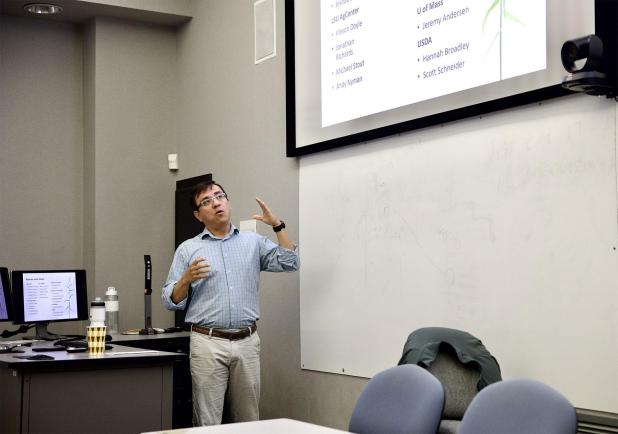
Rodrigo Diaz, entomologist and director of the LSU AgCenter’s Center for Research Excellence for the Study of Invasive Species, presents on the multidisciplinary approach to addressing invasive species at the Management of Invasive Species in Wetlands workshop held on the LSU campus earlier this month. Photo by V. Todd Miller/LSU AgCenter
Workshop on invasive species focuses on study of roseau cane
Scientists from multiple states convened earlier this month to collaborate and share research at the Management of Invasive Species in Wetlands workshop held on the campus of LSU.
Pramod Pantha, a postdoctoral researcher in Maheshi Dassanayake’s laboratory in the LSU Department of Biological Sciences, helped to put the event together and opened the proceedings with a discussion of genomic insights into invasive traits using Phragmites australis, or roseau cane, as a model.
Pantha said the workshop was a way to improve collaboration among researchers. He presented the first chromosome level genome assembly and comparative genomic and transcriptomic study between invasive and native Phragmites.
“The goal of today’s workshop was to bring together faculty, staff and students who are currently engaged or even just interested in invasive species research,” he said. “We want to identify research needs in invasive species management and to seek out funding needs in the future through various sources.”
Rodrigo Diaz, entomologist and director of the LSU AgCenter’s Center for Research Excellence for the Study of Invasive Species, has done extensive research on roseau cane dieback in the Mississippi River Delta. He spoke about the multidisciplinary approach to addressing invasive species.
“We have multiple, different projects running right now,” Diaz said. “The work on Phragmites in the Delta is a hard, physical one, driven by an awesome team of people.”
Diaz showed the differences in healthy Phragmites with tall plants, thick stems and high density versus to those with dieback, which are smaller plants with thinner stems and weak rhizomes.
Kurt Kowalski, research wetland ecologist at the U.S. Geological Survey – Great Lakes Science Center in Ann Arbor, Michigan, gave an alternative, Great Lakes perspective on Phragmites australis.
“I hear Rodrigo talk about restoring Phragmites, which is not usually what we think of up north, but that’s what ecology and science is all about,” he said. “In my area, it creates habitat issues for turtles and fish, problems with water flow, drainage ditches, retention ponds, roadway intersections, beachfront homes and it also becomes a fire hazard when it gets too dry.”
Kowalski went on to talk about the importance of research collaborations when discussing topics like invasive species to get multiple viewpoints and learn best practices from the experts.
One of Dassanayake and Kowalski’s collaborators, Ping Gong, principal investigator at the Environmental Laboratory of the U.S. Army Corps of Engineers, out of Vicksburg, Mississippi, discussed development of gene silencing technologies to control invasive Phragmites using the target genes identified by comparative genomic analysis in the Dassanayake lab.
“Gene silencing is a popular molecular biology tool for studying gene functions,” Gong said. “Over the past several decades, scientists have attempted to explore its power to protect crops from pests and pathogens.”
The workshop also included presentations from AgCenter plant pathologist Jonathan Richards, who detailed exploring genetic diversity and transcriptional responses to stress in Phragmites australis; Aaron DeVries, postdoctoral researcher in the LSU Department of Plant Pathology and Crop Physiology, who discussed mud microbes and their relationship to roseau cane dieback; and Jennifer Kluse, collections manager at LSU’s Shirley C. Tucker Herbarium, who spoke on herbarium resources.
The workshop concluded with a roundtable discussion led by Dassanayake and Pantha, addressing potential collaborative research needs. Three thematic groups emerged: group 1 focused on genetic assessments and control, group 2 on ecosystem-level management and group 3 on stress and physiological assessments. Each group identified key research needs and highlighted existing barriers. Dassanayake stressed the importance of a multidisciplinary approach in devising effective solutions for managing invasive species.
For his part, Pantha was encouraged by the turnout for the workshop, and optimistic about the future of collaborative gatherings such as this.
“We are trying to make it an annual event and hope this is a good start,” said Pantha.
